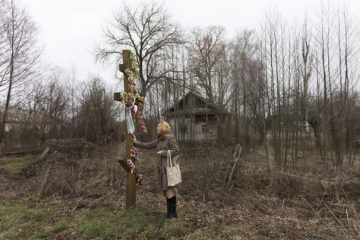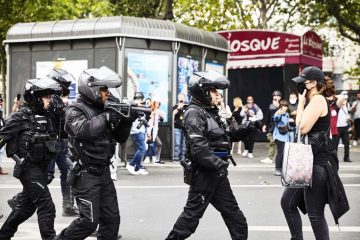JONATHAN ALPEYRIE: a look at his career
Jonathan Alpeyrie’s career spans over two decades, has brought him to 35 countries, and has covered 14 conflict zone assignments, in the Middle East and North Africa, the South Caucasus, Europe, North America, and Central Asia.
Born in Paris in 1979, Jonathan Alpeyrie moved to the United States in 1993. He graduated from the Lycée Français de New York in 1998 and went on to study medieval history at the University of Chicago, from which he graduated in 2003. Alpeyrie started his career shooting for local Chicago newspapers during his undergraduate years. He spent a month driving across the country to create my first photo essay like a professional. The essay focused on the remnant of the Communist era heavy industry. His driver at the time took him to all the major industrial sites, visiting abandoned factories and taking photographs of what once was. The decaying infrastructure was a fascinating reminder of a collapsed system barely 10 years prior.

May 16, 2021 – La Joya, Texas, USA. La Joya has become a new hot bed of passing migrants trying their luck in entering the USA. Strong Border Patrol and local police as well as national guard units are present all along the area in order to arrest as many as possible. ©Jonathan Alpeyrie
After graduating from the University of Chicago in the spring of 2003, Jonathan was sent off to start his first dangerous photo essay which he hoped at the time would help me further to launch his career as a photojournalist. He spent over a month covering gang activity in the Congolese capital of Kinshasa. With the photo essay completed, he returned home and was quickly picked up by Getty images for the reportage section after it was noticed by some editors at the NYC office. 2004, was a watermark year for Jonathan as he started covering wars that very same year, from West Africa to the Caucasus, all for Getty Images.

March 25, 2017, West Mosul, Northern Iraq. A son is crying over the dead body of his father after he was killed after a car bomb blew up on the street. A massive car bomb sent by ISIS has targeted an Iraqi army controlled street on the front lines, destroyed a few humvees, and killing a local civilian who was delivering water to his family. ISIS units has been using car bombs to destroy Iraqi army units and defensive positions, however, civilians usually pay the price of such attacks. ©Jonathan Alpeyrie
I became a war photographer in order to immerse myself into historical situations to then report them back to the public. Cut and dry
Jonathan Alpeyrie
With almost a decade of experience behind him and half a dozen wars under my belt, Jonathan decided to go on his own and leave the agency business partially behind. Dealing directly with his own clients while still working for various photo agencies, he started covering wars in the Middle East and Central Asia, furthering his resume as a war photographer. A year later, the Arab Spring launched a new phase in his career.
With the various conflicts erupting all around the Middle East, Syria started to attract war reporters from all over the world interested in covering this new hot conflict. After two trips to the war-torn country in 2012, Jonathan decided to return in 2013. It happened after he was kidnapped for three months by Islamic rebels.

May 4, 2017 – Northern Mosul, Iraq. The 9th division of the Iraqi army is launching a new operation to relieve pressure on the Federal police in Southern Mosul after suffering multiple setbacks from constant Daesh counter attacks. This new offensive is meant to end all ISIS resistance inside the city, which would free the remainder of the areas still controlled by ISIS fighters. Severe resistance is causing significant casualties amongst Iraqi ranks. ©Jonathan Alpeyrie

March 6, 2022 – Irpyn, Municipality of Kiev, Ukraine. Some civilians have remained on the other side of the river and still trying to escape towards Kiev and seek for safety. Russian forces North West of Kiev are slowly closing in on the Ukrainian capital trying to push South and enter the city. The Ukrainian army is so far is resisting the Russian onslaught and causing significant casualties and delays to the advancing Russian troops. ©Jonathan Alpeyrie
By 2014, right after his release from Syria, he embarked on another voyage, this time into Slavic land to start covering the new hot war: Ukraine. After almost 14 months of coverage, he was injured during a gun battle in Mariupol.

February 6, 2015, Debalteve, Donbass Oblast, Ukraine. A lone woman is standing in front of the bombed out house. Thousands of civilians are still trapped inside the besieged city of Debaltseve. The rail way hub has been hotly contested by both pro-Russian separatists and Ukrainian forces, where hundreds of civilians are soldiers have died since the battle stated 10 days ago. Each day volunteers form all over Ukraine risk their lives to go inside the city to provide with food to the remaining locals still inside the town as artillery fire from both sides rains down in and around the city. ©Jonathan Alpeyrie
That year his career took another turn as he almost permanently stopped working for agencies and focused on some of his big clients like Vanity Fair, CNN, and others, which, interestingly was a reminiscence of the earlier part of his career when he was solely doing photo essays and almost no news. He focused on personal projects which took him closer to a region a new from his previous travels like Mexico and Central America while keeping an eye on South America.

September 9, 2022 – Guayaquil, Guayas, Ecuador. With the ramping up of the drug war in Ecuador, the small South American nation has become one of the major passing point of drug and arms smuggling of the Southern Continent. Indeed, most of the illecit drug trade has its starting point in Peru where the Cocaine is being produce then shipped through Ecuador, then Colombia for refining. The Ecuadorian authorities hare struggling to keep up with the violence the trade induces. ©Jonathan Alpeyrie
After a hiatus from covering wars, he went to Iraq to cover the battle of Mosul in 2017, and took another break from war in 2018, except for some time spent on the front lines in Ukraine, he decided to focus on the drug wars in South America, and more specifically in Brazil. Covid19 cut short his project and focused on the pandemic with an exception: the war in Armenia at the end of 2020.
The War in Ukraine since 2014 never ended but rather was in a state of hiatus with more upsurge of fighting once in a while. February 2022, with the Russian invasion of its neighbor, has had everyone surprised by the scale of its aggression. When the fighting erupted he was in Mexico shooting a story on the drug war, as soon as his assignment ended he departed for the front in Central Ukraine. He spent a month covering the war between the two Slavic nations. Once more, he was drawn back into a conflict.

With the ongoing drug war tearing apart Mexico, it’s Northern boder with the USA has been for decades now a strategic location in order to pass drugs and migrants into the USA, making the area a highly lucrative spot in Tijuana, Baja California , Mexico, March 27, 2023. In recent years, Tijuans has been prone to intense violence between various drug cartels and the government, seeing at some point up to 10 murders each day, making Tijuana one of the most dangerous cities in the Americas. Photographer: ©Jonathan Alpeyrie

May 22, 2019 – Rio de Janeiro, Brazil. An operation is under way to capture and kill drug dealers operating ner the police station. A unit of the famous UPP police unit is operating in one of the most dangerous favela of Rio. Clashes errupt on a daily basis between the military police and drug gangs. Rio Police suffers about 200 killed each year in the hands of the various armes gangs populating the favelas. ©Jonathan Alpeyrie
Alpeyrie has worked as a freelancer for various publications and websites, such as the Sunday Times, Le Figaro Magazine, ELLE, American Photo, GLAMOUR, Aftenposten, Le Monde, & bbc among others. Jonathan Alpeyrie’s career spans over a decade, and has brought him to over 36 countries, covered 14 conflict zones assignments, in the Middle East and North Africa, the South Caucasus, Europe, North America and Central Asia. A future photography book about wwii. Veterans with verve editions are in the works.
Alpeyrie has been published in magazines such as: Paris Match, aftenposten, times (Europe), Newsweek, Wine Spectator, Boston Globe, glamour, bbc, vsd, Le Monde, newsweek, Popular Photography, Vanity Fair, La Stampa, cnn, and Bild Zeit, elle Magazine, Der Spiegel, Le Figaro, marie claire, The Guardian, The Atlantic.
Jonathan Alpeyrie
www.jonathanalpeyrie.com
E: peloponnessian@hotmail.com
@Jonalpeyrie

BECOME A PJH MEMBER
Consider becoming a member of the Photojournalism Hub and receive the benefits of free access to events, Photojournalism Hub resources, premier editorial content, portfolio reviews, photography exhibitions, discounts on our courses and training, whilst you will be supporting our work advocating, advancing social justice and human rights. If there were ever a time to join us, it is now. Support the Photojournalism Hub from as little as £1 every month. If you can, please consider supporting us with a regular amount each month. Thank you. JOIN US HERE











































